When a Game Becomes a Lifestyle: Too Many Bones by Chip Theory Games
Drellen Paleface and I have come to something of an understanding: Every so often, when I have a few hours, we will fight one another until one of us gives up, and then—after the dust settles—we say “Same time next week?”. It might be with slightly different abilities or totally different numbers of people, but Drellen and I have settled into something between friendship and “I’ll get you next time, He-Man”.
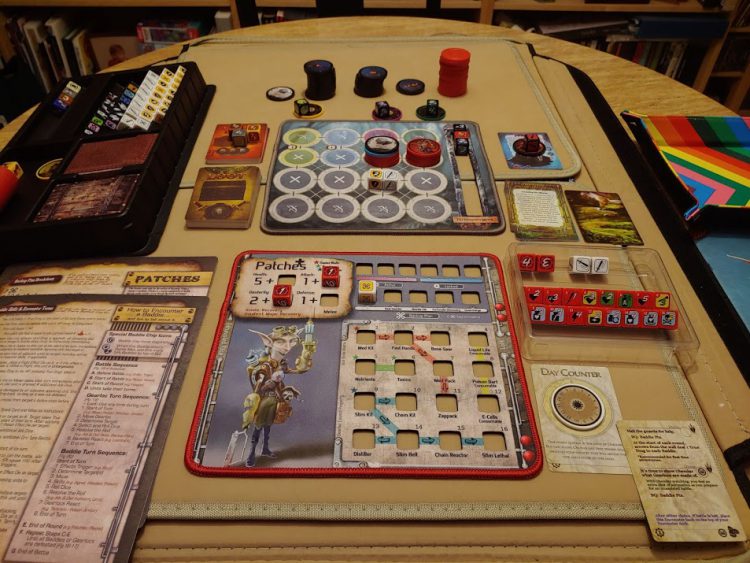
Drellen is not even the most interesting Tyrant in the base box of Too Many Bones, but he’s the first one to ever truly best me in an amazing, down to the wire fashion, and so whenever I find myself wanting to refresh myself of the game—perhaps try out a new Gearloc, or simply challenge myself to a new personal best—Drellen and I square off one more time. Chip Theory Games produces what some people describe as “Lifestyle” games, and in a lot of ways, I think that’s entirely apt. Whether or not they make games that are right for you, though, is a far more personal question, but I’ll do my best to describe my experiences with the game, and whether I think you should give my friend Drellen a call and hang out sometime or not.
Little Heroes, Big Adventure
Too Many Bones is a co-op game for 1-4 players facing off against the various dangers of Daelore, the fictional kingdom of the Too Many Bones universe. Each player takes on 1 of a growing assortment of Gearlocs, a unique spin on a fantasy race that reminds me of an Elf and a Hobbit combined: thin, spindly creatures with large-ish heads and thin, long ears. Although the game deals in fairly routine fantasy tropes of goblins, worgen, dragons, etc., the Gearlocs are a fairly unique and fun race to place in the hands of players.,The art style, rendered the most lovingly on each Gearloc, goes a long way to selling the personality of each character. The starter box of Too Many Bones comes with 4 Gearlocs: Boomer, Tantrum, Patches, and Picket, so for the sake of this review I’ll be limiting your potential experiences and interactions with the game with them, but Chip Theory Games have released numerous expansions to the game. The playable roster now numbers 12, each one bringing unique mechanics and skills to the table. Even in the base box, no two Gearlocs play the same once you get beyond simply rolling attack and defense dice, and even in their unique “jobs”, you’ll likely find that the Gearlocs play a little different than you might expect of a “tank” character (Picket) or a “healer” (Patches) in other games.

At the start of each adventure, players create a unique adventure deck based on the amount of days indicated on the chosen Baddie card, plus 3 basic “starter” cards. If you play Too Many Bones enough, you start to memorize these 3 starter events pretty well, but don’t get cocky—I’ve had runs essentially end pretty spectacularly on Day 2 more than once! Each day is dictated by the card drawn from the adventure deck, and the amount of various adventures and outcomes available even in the base game will take quite a while to see all of. The more interesting side of this is that you can have numerous days in a row that never end with combat taking place at all, and most encounters offer various paths to completion; even the first 3 starter events offer you a choice between essentially setting your game to “normal” or “hard” by dictating how your Gearlocs will initially level up and start their quest. After a day is completed (in whatever fashion that may be), your Gearlocs enter a rest phase where you can attempt to unlock rare Loot chests you may have collected, try to draw new loot to replace junk you don’t like, scout for upcoming enemies, and finally heal before the next day begins. Gameplay continues along these days until you run out of days allotted to your Baddie of choice, in which case your party has failed to defeat the boss and the game is over.
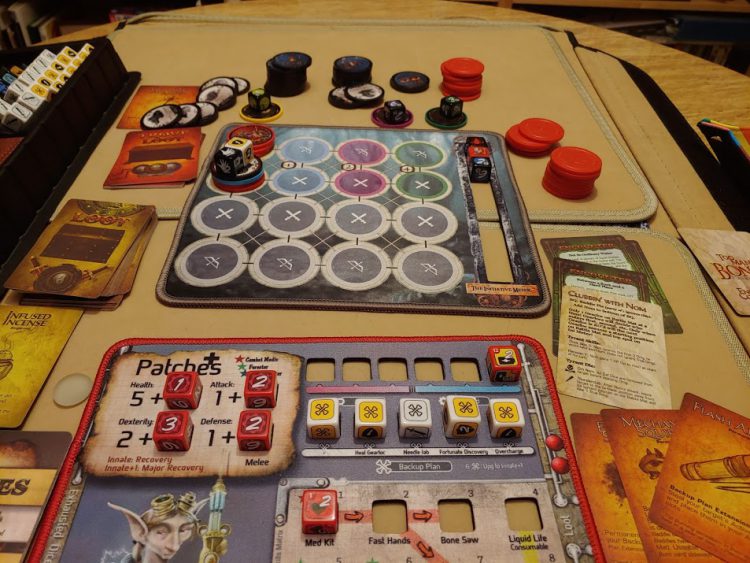
Failure is Always an Option
Perhaps one of the first things to get used to in Too Many Bones is that you are going to fail pretty often at all sorts of things. You may fail daily adventures and challenges, battles, and even fights against the Baddie before coming to a full game-over. Although you’ll lose out on any bonuses you might get from success, failure really just robs you of time in Too Many Bones If you manage your adventure carefully, you can sometimes arrive at the final battle with some extra days available to you just in case things go wrong (or, alternatively, you can go to max out your stats, skills and loot and take one big, all or nothing run at the boss).
I’ve sometimes seen criticism that Too Many Bones is hard or unfair, but that’s perhaps not wholly correct. The game is actually quite fair, but each failure does tend to increase the difficulty of your overall mission, to a point where your failure on Day 2 (such as mine!) might have lost you the game, a fact you only find out 8 days later; while this might seem unfair, it’s really a matter of perspective on how to view Too Many Bones as a game overall. Too Many Bones is, in a lot of ways, a roguelike video-game deconstructed to base parts and then reconstructed through character sheets, dice, and chips. It rewards multiple runs of learning the game’s systems and challenges as one might in various roguelike games—defeat is an opportunity to better understand the game, which in turn invites you to try it again, using what you now know.
This, in some players’ cases, might be the worst thing they’ve ever heard. But from my own experiences, Too Many Bones is one of the only games I’ve learned to appreciate with the idea of having to play (and fail) multiple times before truly starting to understand the game.I’ve heard this a few times-“play through it a few times, then you’ll learn and love it”. Whether its a heavy euro game, worker placement, strategy game, or deckbuilder, I’ve inevitably felt awkward for not understanding what I didn’t “get”.
With Too Many Bones, I found my first playthrough stall at the boss, Nom, as I found him seemingly impossible to defeat. When I finally ran out of days, I took a moment to think about what had transpired, and realized that I’d actually misunderstood quite a few rules and mechanics, but it took my “seeing” my misplays to make them make sense. On my second attempt, I easily mopped the floor with Nom… only to discover I’d actually made a different mistake regarding Loot. When I faced him a thirdtime (which was actually my fifth attempt at the game, as I failed 2 runs before even reaching him) and walked away victorious, I was happy with the fact that I knew I did it “correctly”, and then started thinking of what different ways I could attack the scenario, or how I’d approach him with a different Gearloc.
There are few games I’ve ever felt this proud of “winning” against other than some of my favorite video games. TMB feels like those games–like Demon’s Souls, Slay the Spire, Spelunky, Enter the Gungeon, or even newcomer Hades–in a way that “video game as a board game” hasn’t really ever felt like before. While there’s a ton of flavor in the art and quest cards, TMB’s storylines really come from the events of each adventure and what happens during your run, especially on the battlemat, which is the majority of TMB’s interactive gameplay.
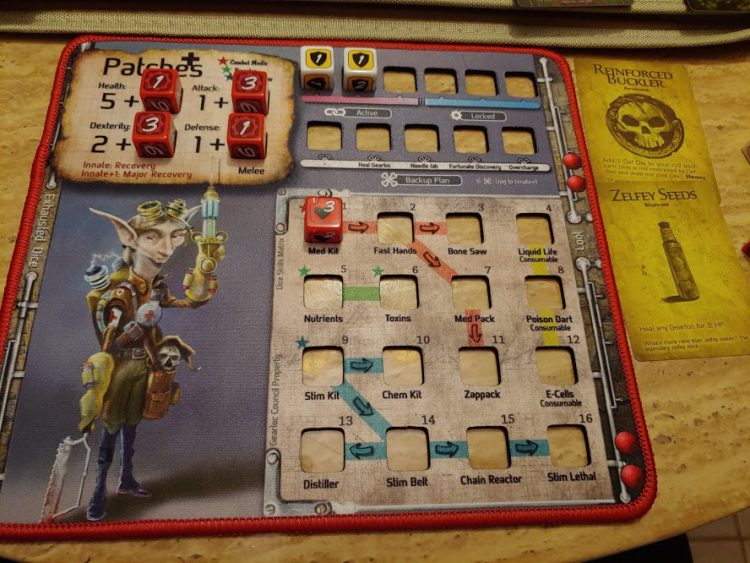
Roll Time Strategy
As much as the name indicates it, you’d be surprised at how few dice you actually get to roll from the swath of dice available to you in the box of TMB. Dice are used as markers, tokens, counters, and, well, actual dice, but the huge amount of bespoke dice are fairly limited per player, and they come out during your encounters on the battlemat. Each encounter starts by totaling the Baddie Points and creating the Baddie Queue, which uses a simple multiplication formula to make battles with more Gearlocs more challenging (or, at least, more populated). Up to 4 Gearlocs and up to 4 Baddies can occupy the battle mat at once, and any extra Baddies are placed into a queue that refills enemies at the start of a new round. Order is determined using initiative ratings, with enemies having prescribed initiatives and Gearlocs rolling a personal initiative die, offering them a chance to place higher or lower depending on their outcome. After the first round, initiative only changes in the sense that enemies leave or enter the initiative meter at either the top or bottom depending on their rank, and Gearlocs always win initiative ties with enemies.
Once battle is underway, a lot of things can happen. This is partly where TMB’s other reputation, “Too Many Rules”, can appear. Frankly, I’m divided on this. There are indeed a lot of keywords to learn and iconography to remember, but the game has both individual character sheets and keywords for Baddies that are, generally, pretty sensible, especially if you play a lot of JRPGs (or really, most video games with various status ailments, buffs, and similar). For example, Thick Skin reduces damage taken by 1, but does not prevent full damage from things such as Poison, Bleed, or other “True” dmg abilities in the game. Although TMB expects you to learn these phrases, they are generally fairly intuitive, and I found myself looking at the reference sheet less and less the more I played the game; at this point, I generally look at it a bit during my warm-up play, and then find I can put the sheet down.
Characters, similarly, have entire sheets that explain their skills and skill trees, unique effects, tips, and other information. I find myself referring to these more than I do the general keywords and terms the game asks you to learn about enemies, mostly due to the fact that I might not play a certain Gearloc for weeks or months at time (I think I’ve played Tantrum the least, and almost never remember how he works right away). There is certainly a burden of knowledge in games of TMB, and if you plan to play this with other people than yourself, it does generally fall to someone in the group becoming a DM or knowledge bank of sorts, which is worth knowing ahead of time if you dislike having to do that with your group of friends.
Battle, once the keywords are sorted and the battle mat set up, falls into a fairly simple yet tactical dance. Enemies will move towards specific characters based on certain traits, and your own characters are free to make a variety of choices on their turn determined by their Dex stat (For example, a Dex stat of 5 would allow me to move 2 times and attack 3, or not move and attack 4 times and roll 1 defense die, etc.). The Dex stat is a unique constraint on doing whatever you want, meaning it is sometimes better to take some lumps from adjacent enemies so you can counter with a stronger selection of skills, attacks, and defense, while other times it may benefit to move away from some enemies and mess with their targeting AI or hunting weakened enemies to finish them off. This obviously gets further complicated by how many Gearlocs are on the table; in solo games, I generally find my character doesn’t need to move much, but in duo or higher games, movement becomes far more important.
What I really enjoy about the battle system is the Bones result on most dice. While a failure may seem unwanted, each character has a “backup” plan that charges up during battle. Aside from a permanent “promotion” option available for maxing out the backup plan, each character gets a variety of unique choices they can use their Bones rolls for, such as healing, doing extra direct damage, or activating unique and interesting abilities. What I enjoy about this is it continues the “failure” theme mentioned above—sometimes, rolling a Bone is exactly what you wanted, rather than you skipping your turn or losing out on being able to do something. In enemy cases, it’s even better, as it means they miss or don’t get armor bonuses, so it’s a nice way to swing the game a little in the Gearloc’s favor (which is actually not something the game does often).
If the idea of dancing around this mat, rolling dice to attack, defend, activate skills, and navigate various diverse enemies and scenarios doesn’t sound interesting, my general recommendation is that you can stop reading the review now; this is not the game for you. In some ways, Too Many Bones is similar to dungeon crawler games in that you encounter enemies, roll dice, and see what happens, and while the core mechanics diverge wildly after that reductive summary, they don’t really differ enough to make the rest of Too Many Bones’ base experience enough to overcome any dislike of that style of gameplay. But if you enjoy those types of action oriented, edge of your seat moments that can come from a momentously good or bad roll, then Too Many Bones might just be the game for you.
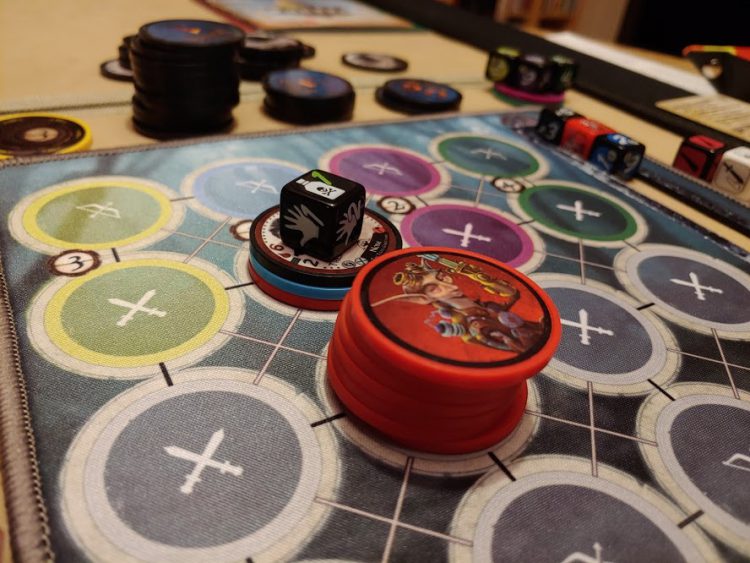
Rogue-Like, Rogue-Lite, or Rogue-Not?
Returning to Too Many Bones feeling like a video game, the battle mat is what most reminds me of various rogue-like/lite dungeon crawlers and RPGs. I found the most fun narratives spun from Too Many Bones came from recounting builds and strategies that I used to overcome an encounter, and then hearing how someone else’s strategy diverged wildly. My favorite bosses are many people’s least favorites, and vice versa, with much of that coming down to playstyle, builds, and strategy. The game rewards experimenting, but it doesn’t always reward it immediately. Like mastering a tough run of Slay the Spire seed, Too Many Bones asks you to try a few more times to see if your ‘Dex HP and Skill Only’ Patches build works or not.
Honestly, I’ve been surprised at what doesn’t work, which is very little, given enough practice and some luck. Like a lot of RNG based games that are procedurally generated, you might see similar encounters and enemies during your replays of Too Many Bones, but you’ll likely never see them in exactly the same order, meaning that an encounter you just could not beat on Day 4 is a breeze on Day 8, and a strategy you were convinced wouldn’t work before made a boss trivial the next time you tried it. This level of variance is why I find myself always opening up Too Many Bones before thinking of any other game I own, because I know that it will scratch the itch I’m looking for, while also getting me thinking about trying something new, giving me a sense of familiarity and excitement each time. Even without the expanded encounter cards from 40 Days of Daelore (which can even change the 3 day set-up routine with new options), I rarely find myself tired of seeing Encounters I’ve done before, because the sequencing and options available to me end up being different. Of course, things aren’t perfect in the world of Daelore, with some of them being mild and others surprisingly annoying.
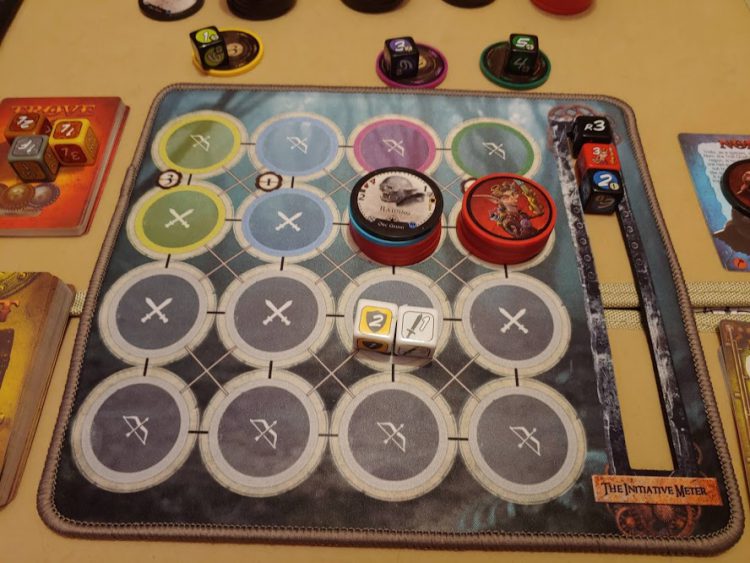
One’s a Party, Two’s a Crowd, Three…
Too Many Bones is both a table hog and not. While the game itself is fairly contained (battle mat, character mat are really all the game ‘needs’ on the table), I always find myself sprawled over my table with reference sheets stacked on one side, health chips and Baddie chips somewhere else, the generic dice still more around, to the point that it feels like somehow I’ve messed up. Also, while the game tells you what Baddie types you need per Boss Baddie, a few encounter cards will ask you to fetch random other Baddies, meaning that even after setting up, you might end up digging into the base box anyway for a chip you didn’t think you needed. This is all fairly minimal, as many games take up huge table real-estate, but somehow Too Many Bones feels like it should both take up that much space and not. I’m not sure why, perhaps it is just my own brain’s way of understanding space, but I occasionally find the state of a table of Too Many Bones underway disorienting and a little anxiety inducing. If anything, expect the game to eat up a lot more table space than you might think.
My second, bigger complaint is that while Too Many Bones is a co-op game, it really isn’t fun above 2, and is perhaps the most enjoyable solo. If you like the idea of playing a traditional Final Fantasy game with your party controlled by yourself and 3 other people, you might really enjoy 4 player Too Many Bones. Personally, I’ve found bigger games something of a bear to get through, and the rules explanations aren’t really even a big part of it. The reality is that Too Many Bones works best when it works fast, getting in a few runs at a specific Baddie over and over, or playing through a semi-campaign of various Baddies back to back (the Age of Tyranny expansion even gives you a literal legacy style campaign option). But with 3 or 4 players, Too Many Bones turns into a slog, with each person waiting for their turn patiently (or not), and then checking the rules (or asking me, or not), and lots of waiting.
Another odd side-effect is that the game at 3 and 4 players is, occasionally, too easy. While the amount of Baddies you might encounter balloon due to the Baddie Queue, certain bosses just can’t handle the amount of players available, and numerous challenges overall become trivial. This is kind of fun, almost like playing the game by cheating, but it has diminishing returns, to the point that it may turn people off because the game seemingly has no challenge.
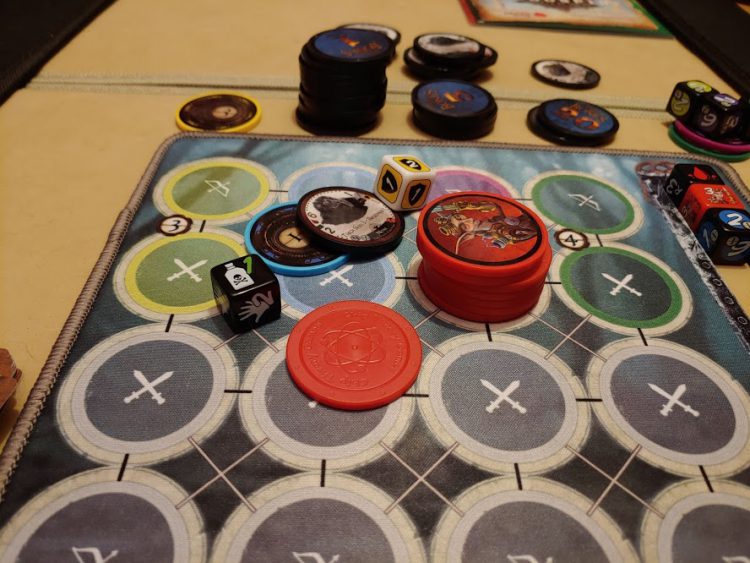
Are You Ready for a Lifestyle Change?
Finally, cost is a common point of discussion when it comes to Too Many Bones. I am not sure this argument is as prevalent as it used to be, though; the game is indeed expensive, coming in at $129.00 for the base game (with shipping, although from Chip Theory Games that’s usually a flat $10). However, since Too Many Bones’ initial printing, board games costing $100 has ballooned to be far more common than it isn’t, and at this point I actually consider the amount of game and quality in Too Many Bones to be undercosted at it’s price-tag for what you get in the box.
Shut Up and Sit Down’s review of the game lambasted TMB a bit for it’s overly deluxe components, which include a plastic style printing of all cards and reference sheet, the bespoke dice, weighted chips for everything except health (which you can buy separate), and neoprene mats for Gearlocs and the Battle Mat. If there is one Hot Take in this entire review, it is that I don’t think this is a fair complaint to make regarding Chip Theory Games products, when publishers like CMON and Awaken Realms publish games that can cost 2 or 3 times this much via Kickstarter for far less quality components and generally fairly dull miniatures. On the other end, Splotter-Spellen games such as Food Chain Magnate ask buyers to pay 100 dollars for games that look like prototypes, Some might say you get some “gamer prestige” for buying from a small indie publisher, but Chip Theory Games only currently publishes 3 titles (which, to me, signals indie publisher) and manages a deluxe bespoke experience for roughly the same cost.
There is also a bit of a false dichotomy regarding expansions and inflated costs. While there are expansions for Too Many Bones, none of them are required. In the time I’ve owned the game, the only expansions I’ve ever gotten were 2 extra characters and Undertow, the semi-spin-off / expansion, and both of those were given to me as a gift less than a month ago. That’s right—all of the playthroughs of Too Many Bones I’ve experienced and fallen in love with came right out of the base box with no expansions or extra expenditure. The only other game I have had a similar experience with is, well, Gloomhaven, which is generally only 30 dollars less than Too Many Bones, and (at least from my experience) ended up costing more than Too Many Bones, since playing Gloomhaven without an organizer is madness.
To sum up, you are getting what you pay for in Too Many Bones, which is a game you can essentially play over and over again, and would need to play exhaustively to run out of things to do in it, and if that happens, can actually be expanded fairly reasonably. Gearlocs and the 2 expansions, 40 Days in Daelore and Age of Tyranny are all $25, recent expansion Splice and Dice is $40, and Undertow—itself comprising 2 new Gearlocs AND a standalone game with new Baddies—is $90. While I don’t want to beat the video game comparison to death, this is another similarity; much of Too Many Bones’ expansions are optional, almost DLC level content, and none save Undertow and Splice and Dice do anything but add to the base game, meaning they aren’t needed. Even Undertow and Splice and Dice don’t alter the base game itself, but offer new games you can experiment with or play, essentially doubling or tripling your content.
But this circles back to the statement of Too Many Bones being a “Lifestyle” game. I’ve found that the more I played it, the less I played other games I usually relied on for solo play, and if given a choice, will almost always go for Too Many Bones. I’ve even found myself playing Too Many Bones more than I play video games, driven by my increased need to stay at my computer for work, the thought of staying there longer to play games gives me both mental and physical pain, leading me to retreat to my more analogue options. Too Many Bones is indeed a lifestyle change. It certainly changed mine, taking over my table more often than any other game I’ve played in the past 2 years, and something I always find myself taking off the shelf when I’ve got an hour or two of downtime and want to get right back to something I know I’ll enjoy.
So, is Too Many Bones right for you? Well, all I can really say at the end is that every penny, every minute, I’ve spent with the game is a joy to play. The plotting, the strategy, the choices, the battles, everything feels unique and fresh while also becoming routine and known. The materials of the game may be basically indestructible, but I swear the corners of my Drellen Paleface card are getting a little worn from my constantly handling it. And now, dear reader, I think it’s time I go say hello to my friendly rival once again, as writing this review has me craving to hear some dice rattling around my table again.


